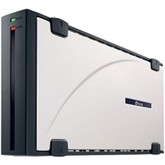Plextor PX-EH25L High Speed NAS Device
![]()
![]()
![]()
![]()
![]()
![]()
![]()
![]()

A network attached storage device is effectively a large hard drive with an Ethernet connector glued to the back – and some intelligence to drive the whole works, of course. Correctly configured, it can behave like a local file server. Multiple users on a private network can store and access files on it.
Unlike USB hard drives, a NAS drive isn’t hosted by a specific computer on its network, and as such, it won’t care which machines are powered up, or how their security is configured.
A NAS drive is a convenient place to store a common database; to maintain files that multiple users need to access without juggling Windows’ increasingly paranoid security features; to expand the storage of multiple machines with a pooled drive; and to keep all those downloaded music files and movies and other stuff no one’s supposed to know about.
Because it’s not connected to a specific computer, a NAS drive can offer a high degree of physical security as well. You can lock it in a secure room, or even confine it to a locked safe, and access it through its Ethernet interface. You can make the device, and hence the data on it, virtually impossible to steal.
The Plextor PX-EH25L NAS drive is a 250 gigabyte network storage server – a 400 gigabyte version is also available. It’s small, convenient, quick and quiet, and it’s quite reliable when it works.
It’s a first-order pig when it doesn’t work, however, and as you might imagine, ours didn’t. While we eventually overcame this, the struggle was decidedly epic.
The PX-EH25L is configured by logging into it with a web browser. If you do so, you’ll probably have your first indication that this is a product which could have used one more trip through the engineering department before it was hustled off to market. For example, here’s what its administration setup screen says:
Don’t switch any workgroups if you use by the domain. After logon the domain, domain user or group sharing will be disable, thus you better backup something and delete sharing before. And after that, the previous domain user or group will not be used.
The internal software of our PX-EH25L was pretty thick with spelling errors and content mistakes that made understanding its more advanced features something of a challenge.
Initially configuring the PX-EH25L isn’t unduly nettlesome if you’re familiar with network hardware and protocols – we wouldn’t recommend it if you’re still having a hard time networking a few computers together. If your network uses DHCP – that is, if it takes care of assigning IP addresses automatically – you can plug the PX-EH25L into your router and be good to go.
If your network uses static IP addresses, such that each machine on it has a specific address assigned to it by an administrator, you’ll need to reconfigure one of them to be a DHCP machine, log into the PX-EH25L, configure it with its intended IP address and then reconfigure your computer to use its original fixed IP address. While none of this is likely to melt your brain, it constitutes a lot of clicking and banging.
Our original application for the PX-EH25L was to permit us to store sensitive information within the protection of a thousand-pound steel vault bolted to the concrete floor of our basement, on the assumption that if anyone broke in, got past the security system, the dogs and the locked internal doors, they’d need a plasma cutter and several days to actually get to the drive. We got everything stored on the PX-EH25L with room to spare, too… just before it stopped working.
We never did learn why our first PX-EH25L decided to leap off a cliff, save that thereafter, it refused to acknowledge any attempts to connect to it through its network interface.
To their credit, Plextor’s support staff were courteous and knowledgeable, but it became clear that we had something of a problem. They insisted that we send the drive back to them, even though they acknowledged that it was bound for an equipment crusher rather than for repair. Having loaded its hard drive with buckets of sensitive information, however, there was no way it was leaving the building.
We spent several weeks in discussion with Plextor over the PX-EH25L. We offered to send it back sans hard drive – they said that if we opened the case, the warrantee was toast and we’d have to pay to get it fixed. We offered to have it crushed locally and send them pictures, or the mangled case without the drive platters. They were horrified.
We resigned ourselves to eating the $299.95 the PX-EH25L had cost us – doing so was easily preferable to potentially disclosing all those sensitive files.
In the end, we cheated – we opened the case, voided the warrantee, wiped the drive in another machine, crossed our fingers and sent it off to be repaired. Plextor presumably crushed it without trying to power it up, as a new – working – PX-EH25L showed up a few weeks later.
To its credit, the replacement PX-EH25L has been running reliably for almost a year, and it does what it says on the box. It’s quick, quiet and really, really spacious. It has solved a number of internal storage and security issues for us, and made all our lives a bit easier.